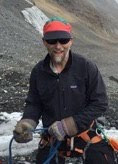Graduate School and Siple Dome
When I returned from the Greenland winter-over, after a sufficient time of relaxing in warm places, I asked Ed Waddington if he had any more glaciology field work for me. His response was that it'd be much easier if I were a graduate student- and so I applied to graduate school.

Graduate school entailed a lot of time in the office as well!
I entered graduate school in the fall of 1999, and immediately started work on a project at Siple Dome, Antarctica.

The main structures at Siple Dome, known as Jamesways.
This project, headed by Gary and Ed, built on the success we'd had in Greenland with our new shallow logging technique, and we installed pipes in an array of shallow boreholes across Siple Dome. We also made temperature logs in the main (1000 meter) borehole, and measured vertical motion using my video camera technique I'd developed a few years earlier.
The Siple Dome project lasted 3 years, and over the 3 field seasons we had many great successes. During the first season, I noticed that while raising my video camera I could see different shades of light and dark passing by on the borehole walls. I did some experiemnts with the camera and this led me to a new line of inquiry that has developed into Borhole Optical Stratigraphy (BOS), a technique I developed over the next several years and eventually formed the basis for my PhD dissertation, as well as several successful proposals to the National Science Foundation. I wrote a paper about the ability to detect annual layers using BOS that was published in Geophysical Research Letters. You can view the paper in HTML or PDF format.
In our second year, Gary and I enlarged our field team when we brought Rolf Tremblay, a math and science teacher from Goodman Middle school in Gig Harbor, Washington. Rolf took the photos in this post during his time in Antarctica.

Rolf standing atop Observation hill, near McMurdo Station.

Rolf helping me measure vertical motion in the upper layers of the snowpack.
Also joining our team in the second and third years was Ryan Bay, from the University of California at Berkeley. Ryan had a new boehole tool for measuring the amount of dust in the ice, and we tested it at Siple Dome.

Ryan and I lower the dust logger into the borehole- it goes straight down for a kilometer!
The Siple Dome project was a great success, and at the end of the last season I was sad to see the end of the project. But there is almost always another interesting project to pursue- it's one of the great things about glaciology, and polar science in general.


0 Comments:
Post a Comment
<< Home